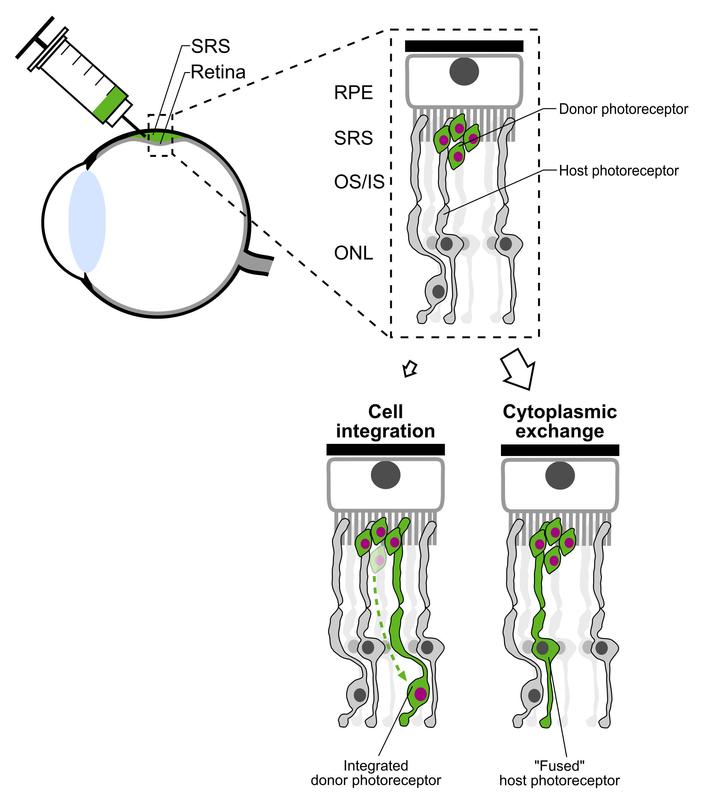Paradigm shift in the research field of photoreceptor transplantation

See press release. © CRTD
The research group of Prof. Dr. Marius Ader, group leader at the DFG-Center for Regenerative Therapies Dresden (CRTD), Cluster of Excellence at TU Dresden, introduces a new understanding of the mechanism of cell transplantations that aim to improve retinal function. Affected retinal degenerative diseases are for example age-related macular degeneration (AMD) and Retinitis Pigmentosa (RP) with a current total of approximately 1.6 million patients affected in Germany.
Dresden. The study presented here describes a paradigm shift in the research field of photoreceptor transplantation. Photoreceptors comprise the rods and cones in the retina. Whereas rods are responsible for vision in dim light conditions (“night vision”), cones are responsible for daylight vision and color recognition. In case of retinal degenerative diseases, usually the photoreceptors are affected – leading to clinical conditions like age-related macular degeneration (AMD) or Retinitis Pigmentosa (RP).
First AMD symptoms comprise a blurred and distorted perception in the center of the visual field due to dysfunction and loss of cones. This leads to difficulties in the recognition of people and to a loss of the reading ability. AMD is the most common cause for blindness in Germany. On the other hand, RP leads to a gradual reduction of the visual field due to rod photoreceptor dysfunction and death.
The affected patients develop a “tunnel vision” that leads step by step to a complete blindness as cones are finally also lost. The high number of affected patients, with about 5000 new cases of registered blindness every year, emphasizes the relevance of research in this field.
The study introduced here examines the mechanism underlying the rescue of retinal function observed previously in mouse models of retinal degeneration. With respect to the transplantation of photoreceptors, it was assumed that there is a structural integration of donor photoreceptors into the retinal tissue resulting in functional replacement of endogenous photoreceptors (“cell replacement therapy”). The results presented here show that this is not the case.
The donor cells actually remain at the injection site and instead transfer cell material to endogenous photoreceptors of the recipient. This is a new, unexpected mechanism of cell material transfer between donor and recipient photoreceptors and its potential for the development as a therapy needs to be examined in further detail now (“cell support therapy”).
Further studies carried out by Professor Ader and his research team aim to identify the cellular and molecular preconditions for this process. “Our results open up a potential new therapeutic approach for the treatment of retinal degenerations. Donor cells might support remaining but dysfunctional photoreceptors instead of replacing them.”, Professor Ader explains.
Since 2007, Marius Ader is working as a research group leader at the CRTD. From 2003-2007 he worked as a Senior-Postdoctoral Fellow at the Smurfit Institute of Genetics, Trinity College Dublin (Ireland). Between 2000 and 2003 he was active as a postdoctoral fellow at the Universitätsklinikum Hamburg-Eppendorf (UKE) and the Zentrum für Molekulare Neurobiologie Hamburg (ZMNH).
Publication
Santos-Ferreira T*, Llonch S*, Borsch O*, Postel K, Haas J, Ader M. Retinal transplantation of photoreceptors results in donor–host cytoplasmic exchange. Nat. Commun. 7, 13028. doi: 10.1038/ncomms13028 (2016).
Press Contact
Franziska Clauß, M.A.
Press Officer
Phone: +49 351 458 82065
E-Mail: franziska.clauss@crt-dresden.de
Founded in 2006, the DFG Research Center for Regenerative Therapies Dresden (CRTD), Cluster of Excellence at the TU Dresden has now passed the second phase of the Excellence Initiative which aims to promote top-level research and improve the quality of German universities and research institutions. The goal of the CRTD is to explore the human body's regenerative potential and to develop completely new, regenerative therapies for hitherto incurable diseases. The key areas of research include haematology and immunology, diabetes, neurodegenerative diseases, and bone regeneration. At present, eight professors and ten group leaders are working at the CRTD – integrated into an interdisciplinary network of 87 members at seven different institutions within Dresden. In addition, 21 partners from industry are supporting the network. The synergies in the network allow for a fast translation of results from basic research to clinical applications.
Media Contact
All latest news from the category: Life Sciences and Chemistry
Articles and reports from the Life Sciences and chemistry area deal with applied and basic research into modern biology, chemistry and human medicine.
Valuable information can be found on a range of life sciences fields including bacteriology, biochemistry, bionics, bioinformatics, biophysics, biotechnology, genetics, geobotany, human biology, marine biology, microbiology, molecular biology, cellular biology, zoology, bioinorganic chemistry, microchemistry and environmental chemistry.
Newest articles

Peptides on Interstellar Ice
A research team led by Dr Serge Krasnokutski from the Astrophysics Laboratory at the Max Planck Institute for Astronomy at the University of Jena had already demonstrated that simple peptides…

A new look at the consequences of light pollution
GAME 2024 begins its experiments in eight countries. Can artificial light at night harm marine algae and impair their important functions for coastal ecosystems? This year’s project of the training…

Silicon Carbide Innovation Alliance to drive industrial-scale semiconductor work
Known for its ability to withstand extreme environments and high voltages, silicon carbide (SiC) is a semiconducting material made up of silicon and carbon atoms arranged into crystals that is…





















